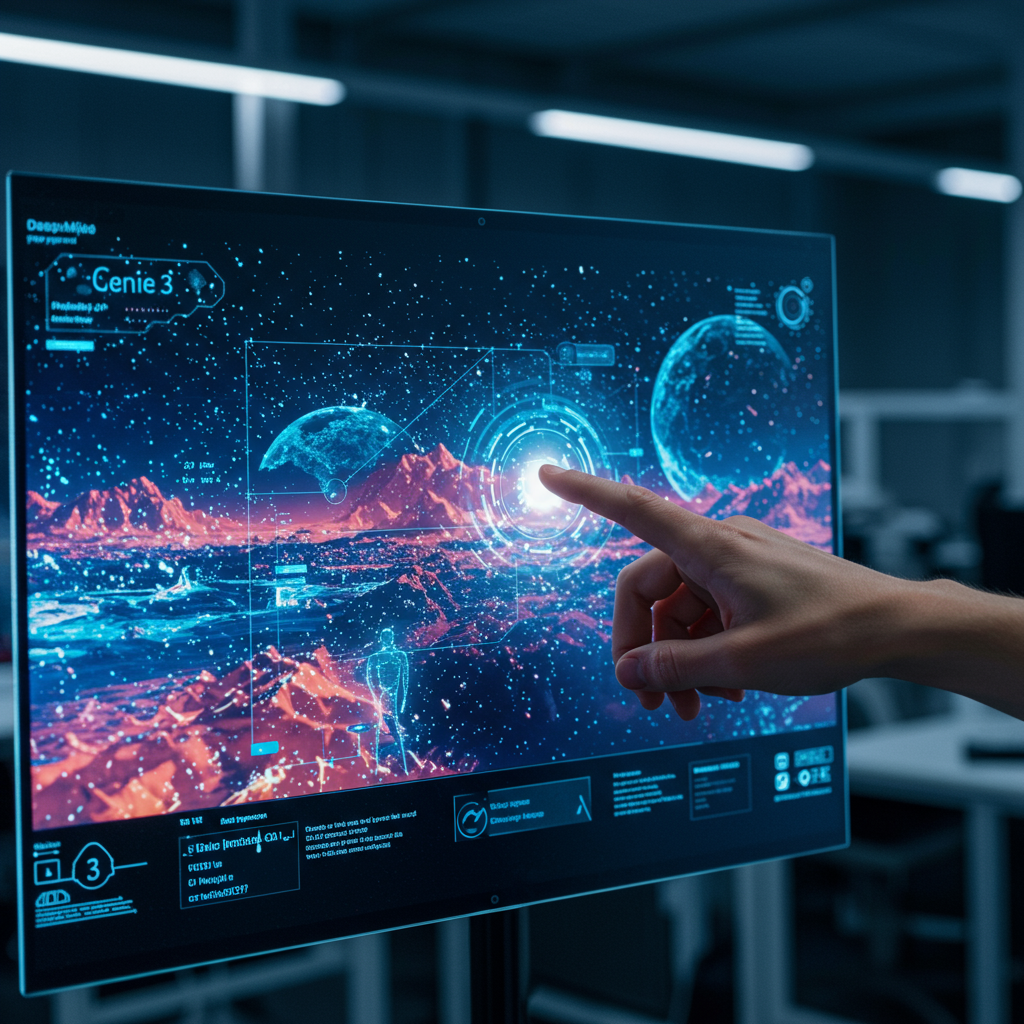Google DeepMind has unveiled Genie 3, a monumental leap in the evolution of AI world models. This groundbreaking system is designed to generate highly diverse, interactive, and consistent virtual environments from simple text prompts. Imagine navigating a vibrant, dynamically generated world at 24 frames per second in 720p, where every action influences the environment around you. Genie 3 marks a significant stride toward Artificial General Intelligence (AGI) by providing an unprecedented sandbox for training and evaluating AI agents in complex, simulated realities.
Understanding the Power of AI World Models
World models are sophisticated AI systems that build an internal understanding of how the world operates. They can then use this knowledge to simulate aspects of reality, predicting environmental changes and the impact of actions taken within it. Think of them as the AI’s “imagination,” allowing it to practice and learn without needing real-world data for every scenario. This capability is paramount for the development of advanced AI, particularly for training “embodied agents”—AI systems designed to interact with and navigate 3D virtual settings, much like humans.
Google DeepMind’s journey into simulated environments spans a decade, encompassing AI agents for real-time strategy games and the development of open-ended learning and robotics simulations. Genie 3 builds on the legacy of its predecessors, Genie 1 and Genie 2, which were foundational world models, and also draws insights from video generation models like Veo 2 and Veo 3, known for their intuitive grasp of physics. While previous models generated coherent worlds, Genie 3 distinguishes itself with unparalleled real-time interactivity and significantly improved environmental consistency, overcoming limitations seen in earlier systems such as Decart’s Oasis.
Key Innovations Driving Genie 3’s Capabilities
Genie 3 isn’t just an upgrade; it introduces critical advancements that redefine interactive AI. Its ability to create dynamic, responsive worlds in real-time is a game-changer.
Real-Time Interaction and High Fidelity: Unlike its predecessors, Genie 3 allows users to navigate its generated worlds using keyboard input, rendering scenes at a crisp 720p resolution and a fluid 24 frames per second. This real-time performance is crucial for immersive experiences and dynamic AI training.
Unprecedented Environmental Consistency: A core challenge in generative models is maintaining consistency over time. Genie 3 addresses this by employing an auto-regressive generation process, where each new frame considers the entire previously generated trajectory. This sophisticated memory allows the environment to remain consistent for “multiple minutes,” a vast improvement over Genie 2’s limited visual retention. Users can even revisit a location from a minute ago, finding elements precisely as they left them.
- Promptable World Events: Dynamic Alterations: This is considered Genie 3’s “killer feature.” Beyond simple navigation, users can dynamically alter the simulated world through text prompts. Imagine typing “add a herd of deer” while skiing down a mountain, and watching them appear seamlessly. This capability to change weather, introduce objects, or add characters in real-time opens up infinite “what-if” scenarios, invaluable for stress-testing and refining AI behaviors.
- deepmind.google
- arstechnica.com
- www.engadget.com
- www.techeblog.com
- techcrunch.com
Exploring Diverse Worlds: Genie 3’s Imaginative Range
The versatility of Genie 3 is truly remarkable, showcasing its ability to interpret and generate a vast array of concepts.
Simulating Realistic and Fantastical Scenarios
Genie 3 can model intricate physical properties and natural phenomena, making its simulations feel incredibly lifelike. It can generate environments that depict water and lighting effects, as seen in scenarios like navigating volcanic terrains, jetskiing during festivals, or exploring deep-sea ecosystems. The model excels at simulating vibrant natural worlds, including realistic animal behaviors and complex plant life. Prompts describing glacial lake runs, bioluminescent jellyfish, Japanese zen gardens, or lush foliage result in highly detailed and dynamic ecosystems.
Beyond the natural, Genie 3 also taps into pure imagination, crafting fantastical scenarios and expressive animated characters. It can bring to life fluffy creatures on rainbow bridges, origami-style lizards, enchanted forests with glowing tree houses, and even surreal transformations where land rips free and floats. This imaginative capacity highlights its potential for creative industries.
Transcending Time and Geography
Genie 3’s capabilities extend to exploring specific locations and historical settings. Users can virtually traverse real-world mountainous regions like the Alps, explore detailed recreations of Venice’s canals, or step back in time to ancient historical sites such as the Palace of Knossos in its prime. This ability to transcend geographical and temporal boundaries offers immense possibilities for education, historical research, and immersive storytelling.
Genie 3’s Impact on AI Research and Future Horizons
DeepMind primarily positions Genie 3 as a fundamental research tool for advancing AI. The consistent, interactive environments it generates are proving critical for embodied agent research. Compatibility tests with Google DeepMind’s SIMA agent, a generalist agent for 3D virtual settings, demonstrated success. SIMA could pursue various goals within Genie 3’s worlds, with the environment reacting dynamically to its actions. This capacity to execute longer sequences of actions and achieve more complex goals is a vital step for AGI development.
The pursuit of AGI faces a key limitation: the scarcity of reliable training data for AI models. Genie 3 aims to overcome this by supplying “essentially unlimited interactive worlds,” supplementing finite real-world data. It acts as an advanced training ground, exposing AI systems to complex “what if” scenarios not covered in pre-training. For example, it could train a self-driving car to react safely to unexpected pedestrian behavior. This efficient training leads to more robust and reliable AI models, preparing them for real-world deployment.
Current Limitations and Responsible Development
Despite its breakthroughs, Genie 3 is not without its acknowledged limitations. The action space for agents is currently constrained, although promptable world events offer broader environmental interventions. Modeling complex interactions between multiple independent agents remains a challenge. The system struggles to simulate real-world locations with perfect geographic accuracy and often renders text unclearly unless explicitly provided in the input. Furthermore, continuous interaction duration is limited to a few minutes, though the long-term goal for extensive AI training is “hours” of consistency. Intensive processing power is also required, contributing to its currently restricted access.
Google DeepMind is deeply committed to responsible development for foundational technologies like Genie 3. Recognizing the new safety and ethical challenges posed by its open-ended, real-time capabilities, they are collaborating closely with their Responsible Development & Innovation Team. Genie 3 is currently available as a limited research preview to a select cohort of academics and creators, gathering crucial feedback for safe and responsible deployment.
The Future Potential of World Models
DeepMind believes Genie 3 marks a significant moment for world models, poised to impact AI research and generative media. Its potential applications are vast. In education, it could facilitate immersive learning experiences, allowing students to interactively explore historical contexts or practice complex activities. For training, it provides a dynamic sandbox for robots and autonomous systems, refining their skills in ways static simulations cannot. For creators, Genie 3 serves as a powerful tool for rapidly developing concepts, from intricate gaming levels to elaborate film sets, potentially reducing production complexities.
While Google has hinted at playable world models, perhaps combining strengths of Veo for visuals and Genie for interactive world generation, Genie 3’s primary focus remains a research tool. Its ability to create dynamic, consistent, and interactive virtual worlds represents a critical stepping stone toward more capable and general AI systems, shaping the future of human-computer interaction and AI development.
Frequently Asked Questions
What is Google DeepMind’s Genie 3 and how does it advance world models?
Google DeepMind’s Genie 3 is a pioneering AI system designed to generate diverse, interactive virtual environments in real-time from text prompts. It significantly advances world models by offering unprecedented real-time navigation at 720p resolution and 24 frames per second, coupled with environmental consistency that lasts for several minutes. This breakthrough provides an “essentially unlimited” curriculum of rich simulation environments, crucial for training advanced AI agents and progressing toward Artificial General Intelligence (AGI).
What unique interactive capabilities does Genie 3 offer, and how does it achieve consistency?
Genie 3 offers real-time navigation using keyboard input and a revolutionary feature called “promptable world events,” allowing users to dynamically alter the simulated environment via text commands (e.g., changing weather, adding characters). It achieves remarkable environmental consistency through an auto-regressive generation process, where each new frame takes into account the entire previously generated trajectory. This sophisticated memory enables it to retain visual consistency for multiple minutes, even if a user revisits a previously explored area.
Is Google DeepMind’s Genie 3 available to the public, and what are its current limitations?
Currently, Google DeepMind’s Genie 3 is not available to the general public. It is offered as a limited research preview to a small cohort of academics and creators for feedback and responsible development. Its limitations include a constrained action space for AI agents, challenges in simulating interactions between multiple independent agents, difficulty rendering real-world locations with perfect accuracy, often unclear text rendering, and a limited continuous interaction duration of only a few minutes, although DeepMind aims for hours of consistency in the future.


